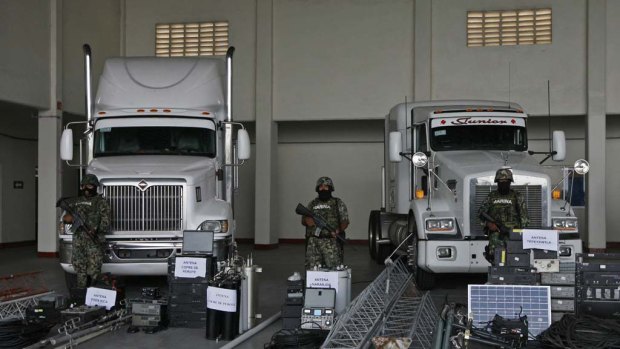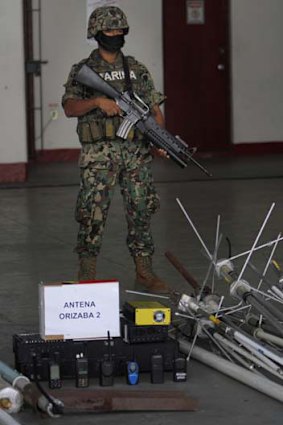When convoys of soldiers or federal police move through the scrubland of northern Mexico, the Zetas drug cartel knows they are coming.
The alert goes out from a taxi driver or a street vendor, equipped with a high-end handheld radio and paid to work as a lookout known as a "halcon," or hawk.

The Mexican Navy stands guard over seized telecommunications equipment, allegedly built by the Zetas drug cartel.
The radio signal travels deep into the arid countryside, hours by foot from the nearest road. There, the 2-meter-tall dark-green branches of the rockrose bush conceal a radio tower painted to match. A cable buried in the dirt draws power from a solar panel.
A signal-boosting repeater relays the message along a network of powerful antennas and other repeaters that stretch hundreds of kilometers across Mexico, a shadow communications system allowing the cartel to coordinate drug deliveries, kidnapping, extortion and other crimes with the immediacy and precision of a modern military or law-enforcement agency.

The Mexican army and marines have seized hundreds of pieces of communications equipment in at least three operations since September.
The Mexican army and marines have begun attacking the system, seizing hundreds of pieces of communications equipment in at least three operations since September that offer a firsthand look at a surprisingly far-ranging and sophisticated infrastructure.
Current and former U.S. law-enforcement officials say the equipment, ranging from professional-grade towers to handheld radios, was part of a single network that until recently extended from the U.S. border down eastern Mexico's Gulf coast and into Guatemala.
The network allowed Zetas operatives to conduct encrypted conversations without depending on the official cellphone network, which is relatively easy for authorities to tap into, and in many cases does not reach deep into the Mexican countryside.
"They're doing what any sensible military unit would do," said Robert Killebrew, a retired U.S. Army colonel who has studied the Mexican drug cartels for the Center for a New American Security, a Washington think tank. "They're branching out into as many forms of communications as possible."
The Mexican army said on Dec. 4 that it had seized a total of at least 167 antennas, 155 repeaters, 166 power sources, 71 pieces of computer equipment and 1,446 radios. The equipment has been taken down in several cities in the Gulf coast state of Veracruz and the northern states of Nuevo Leon, Coahuila, San Luis Potosi and Tamaulipas.
The network was built around 2006 by the Gulf cartel, a narcotics-trafficking gang that employed a group of enforcers known as the Zetas, who had defected from Mexican army special forces. The Zetas split from the Gulf cartel in 2010 and have since become one of the nation's most dominant drug cartels, with profitable sidelines in kidnapping, extortion and human trafficking.
The network's mastermind was Jose Luis Del Toro Estrada, a communications expert known as Tecnico who pleaded guilty to conspiracy to distribute cocaine in federal court in Houston, Texas, two years ago.
Using millions of dollars worth of legally available equipment, Del Toro established the system in most of Mexico's 31 states and parts of northern Guatemala under the orders of the top leaders in the Gulf cartel and the Zetas. The Gulf cartel boss in each drug-smuggling territory, or plaza, was responsible for buying towers and repeaters as well as equipping his underlings with radios, according to Del Toro's plea agreement.
Del Toro employed communications specialists to maintain and run the system and research new technology, according to the agreement.
Mexican authorities, however, presented a different picture of the cartel radio infrastructure, saying it was less monolithic than the one described by U.S. authorities. A Mexican military official denied that the army and navy have been targeting one network that covered the entire Gulf coast. The operations had been focused on a series of smaller, local systems that were not connected to each other due to technical limitations, he said.
"It's not a single network," the official told The Associated Press on condition of anonymity due to the sensitivity of the topic. "They use it to act locally."
In recent years, reporters traveling with the Mexican military have heard cartels using radio equipment to broadcast threats on soldiers' frequencies. The military official told the AP that the signals are now encrypted, but cartels are still trying to break in.
At least until recently, the cartel's system was controlled by computers that enabled complex control of the radio signals, allowing the cartel to direct its communications to specific radios while bypassing others, according to Grupo Savant, an intelligence and security consulting firm in Washington that has firsthand knowledge of Mexico's cartel operations.
The radio system appears to be a "low-cost, highly extendable and maintainable network" that shows the Zetas' sophistication, said Gordon Housworth, managing director of Intellectual Capital Group, LLC, a risk- and technology-consulting firm that has studied the structure and operations of Mexican cartels and criminal groups.
Other Mexican criminal organizations maintain similar radio networks, including the Sinaloa cartel, based in the Pacific coast state of the same name, and the Barrios Azteca street gang, which operates in Ciudad Juarez, across from El Paso, Texas, a U.S. law-enforcement official said. The Zetas' system is the largest, however, the official said, speaking on condition of anonymity because of the sensitivity of the topic.
The Mexican raids are "a deliberate attempt to disrupt the business cycle of the cartels," said one former law-enforcement official with direct knowledge of the network. "By going after command and communications you disrupt control."
Law-enforcement officials and independent analysts described the operations against the Zetas' communications system as significant short-term victories in the fight against the cartel.
"The seizures show that the organization is scrambling," said Steven Dudley, co-director of InSight, a group that analyzes and investigates organized crime in Latin America.
The longer-term impact is unclear. The cartel has had little difficulty in replacing radio gear and other equipment seized in smaller operations in recent years. And contacts among the highest-ranking Zetas operatives tend to take place in highly encrypted communications over the Internet, according to Grupo Savant.
Certainly, cartel radio equipment is a near-ubiquitous presence for Mexicans living along the front lines of the drug war.
In the state of Tamaulipas, across the border from eastern Texas, many antennas are concealed in the foliage of the rockrose, an invasive shrub that has spread across much of the state's open land.
Even from a few meters away it's nearly impossible to see the towers or their power cables.
In Nuevo Laredo, the Zetas' first stronghold, antennas sprout from rooftops and empty lots. One soldier told the AP that even when authorities took down an antenna there, it was swiftly replaced.
AP